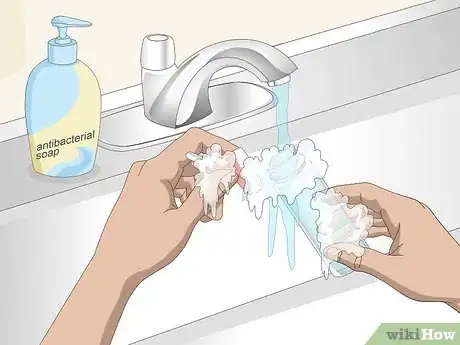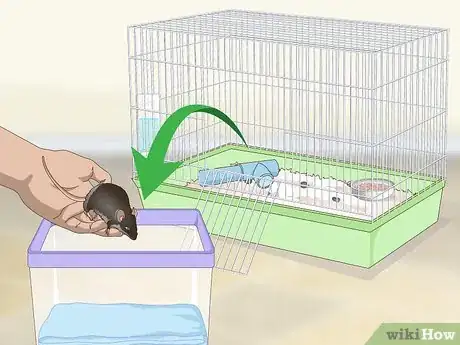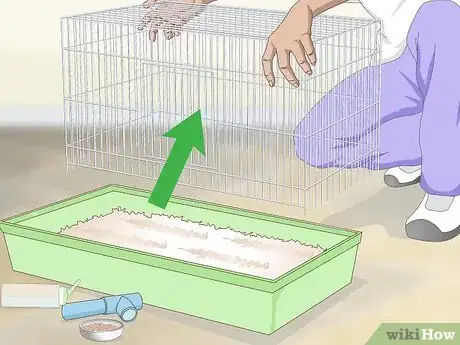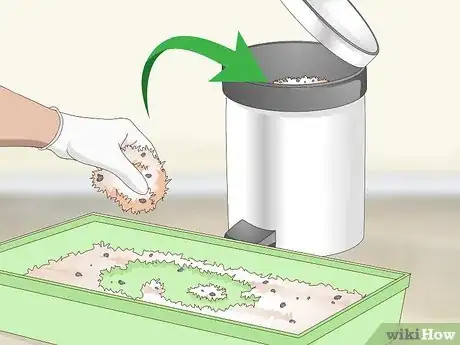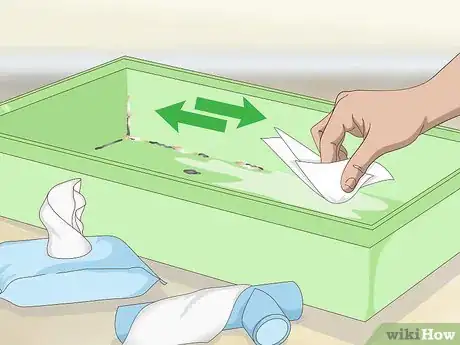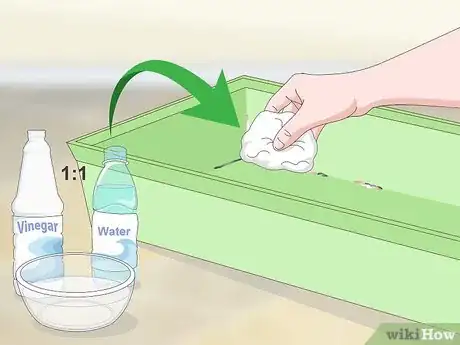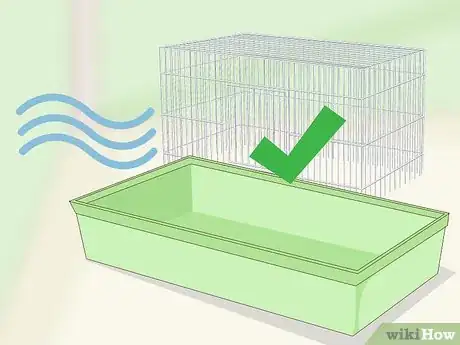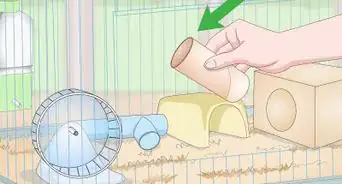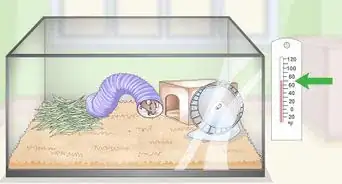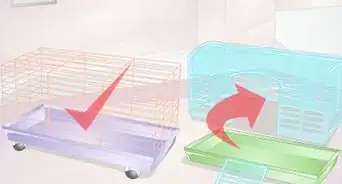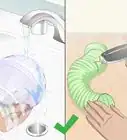This article was co-authored by wikiHow Staff. Our trained team of editors and researchers validate articles for accuracy and comprehensiveness. wikiHow's Content Management Team carefully monitors the work from our editorial staff to ensure that each article is backed by trusted research and meets our high quality standards.
This article has been viewed 44,718 times.
Learn more...
In order to keep your pet mouse happy and healthy, you’ll need to clean its cage frequently to remove built up bacteria and soiled bedding. Thankfully, the cleaning process is incredibly simple, takes very little time to complete, and can be done using common household materials.
Steps
Performing Daily Maintenance
-
1Rinse your mouse’s food bowl with soap and water. Once per day, take your mouse’s food bowl and run it under a stream of hot water. Then, squirt a few drops of antibacterial soap onto a scrubbing brush and use it to clean the bowl thoroughly. Once you’re done, dry the bowl off with a clean towel.[1]
- Make sure the bowl is completely dry and free of soap before filling it up with food.
- Cleaning the food bowl every day will help keep your mouse from getting sick.
-
2Wash out your mouse’s water bottle with soap and water. Just like with the food bowl, remove your mouse’s water bottle once a day and clean it using antibacterial soap and water. Make sure to scrub both the outside of the container and the inside, then dry the bottle off with a fresh cloth.
- If you see any bedding inside the water bottle’s nozzle, use your fingers to get it out.[2]
- Once you’ve finished cleaning the bottle, don’t forget to fill it with fresh water. If you notice any soap suds in the water, dump everything out and refill the bottle.
Advertisement -
3Change out any soiled bedding. When you go to clean your pet’s food bowl and water bottle, look around the cage for any extremely wet bedding, excessively smelly bedding, or bedding with fecal matter in it. If you find any, use a pair of tongs to move it to a trash can.[3]
- Unless you’re doing a deep cleaning, only replace the soiled portion of the bedding. Mice mark their territory using urine, so changing out all the bedding may cause them to urinate around the entire cage.
Doing Weekly Deep Cleanings
-
1Move your mouse to a temporary container. Before you start cleaning, take your mouse out of its cage and move it to a safe enclosure. If possible, use a container made of glass, plastic, or metal so your mouse can’t chew through it.
- Fish tanks, thick plastic buckets, and metal crates all make great temporary containers.
- If necessary, you can use a container made of wood, like a shipping crate, or cardboard, like a shoebox. Just make sure you keep an eye on your pet so it doesn’t escape.
-
2Disassemble the cage. Open the cage and take out your mouse’s food bowl, water bottle, wheel, toys, and furniture items. Then, disassemble the cage by removing its lid and disconnecting its base and central chamber.
- If your cage has multi-part accessories, like tunnels, disassemble each part so you can clean them individually.
-
3Throw out your mouse’s bedding. Grab a pair of tongs or put on disposable sanitary gloves. Then, use the tongs or your hands to move all of the cage’s bedding to a trash can or garbage bag. Once you’ve removed all the bedding, pick up and dispose of any remaining food or fecal particles.[4]
- If your cage is light enough, you can simply pour the bedding into the trash.
-
4Clean your cage and its accessories with baby wipes. Rub scentless, residue-free baby wipes along your cage’s exterior and interior surfaces. Then, do the same with your cage’s various accessories. When you’re done, you should have cleaned every part of the container, including its base, living chamber, lid, and your mouse’s toys and furniture items.
- Make sure to clean the insides of enclosed accessories like tunnels.
- If you have a wire cage, don’t forget to wipe down the areas in between the wires.
- Clean your mouse’s food bowl and water bottle with soap and water like you do during daily cage maintenance.
-
5Use a 1 part vinegar, 1 part water solution to clean particularly bad areas. To deal with stubborn spots that the baby wipes can’t clean up, create an acidic solution that’s either 1 part white vinegar and 1 part water or 1 part bleach and 30 parts water. Pour your solution onto a clean cloth to dampen it, then rub the cloth over the stubborn areas to remove them.
- Acidic solutions can harm your pet when used too frequently, so you should think of them as a last resort. As a general rule, do not use acidic solutions more than once a month.
-
6Let your cage dry. Once you’ve finished cleaning the cage, put it in a well-ventilated area so it can air dry. If you used nothing but baby wipes, expect this process to take between 5 and 10 minutes. If you used an acidic solution, your cage may take anywhere between 10 minutes and an hour to dry.
- If your cage reuses to dry, or if you want to speed up the process, you can wipe down any moist areas with a clean towel or paper towels.
-
7Fill the cage with fresh bedding. After cleaning the cage, cover the base of your cage with a 1 to 3 in (2.5 to 7.6 cm) layer of fresh, dry bedding. If necessary, use your hands to flatten and smooth out the material.[5]
- Make sure to use bedding materials made of paper, wood, corn cob, hay, soil, or hemp.
- Do not use bedding materials like cat litter or cotton as these can harm your pet.
-
8Reassemble the cage and replace your mouse. Reconnect your cage’s base, central chamber, and lid. Then, reassemble and replace your pet’s wheel, food bowl, water bottle, toys, and furniture items. Once everything is back together, you can return your mouse to its home cage.
- If you did not already, make sure to refill your mouse’s food bowl and water bottle.
-
9Use baking soda outside your mouse’s cage to absorb odors. If your mouse’s cage gets particularly stinky during the week, try placing an open container or sachet filled with baking soda in the room near the cage. Doing this will help trap odors coming from the cage.[6] However, do not place the baking soda directly in the cage itself or anywhere that the mouse can easily access it, since the fine powder may irritate your mouse’s lungs, skin, or eyes.
- Baking soda may also be toxic to mice if ingested. In fact, it is often recommended as a natural rodent pesticide when mixed with baits such as chocolate or peanut butter.
- If you’d prefer, you can use activated carbon or zeolite instead of baking soda. For the best results, though, use all 3 at the same time!
Community Q&A
-
QuestionWhat is a safe disinfectant for a mouse's cage?
 Community AnswerYou can make a mixture of 50% water and 50% vinegar to use on the inside of the cage. Just rinse the cage with water afterwards.
Community AnswerYou can make a mixture of 50% water and 50% vinegar to use on the inside of the cage. Just rinse the cage with water afterwards. -
QuestionHow often should a mouse cage be cleaned?
 Community AnswerAt least once a week, if not more.
Community AnswerAt least once a week, if not more. -
QuestionDo mice need to be bathed?
 Community AnswerProbably not. Mice are obsessive groomers, so chances are you won't have to bathe them often, if at all.
Community AnswerProbably not. Mice are obsessive groomers, so chances are you won't have to bathe them often, if at all.
Warnings
- While cleaning, keep an eye on your mouse to make sure it doesn’t chew through its temporary container.⧼thumbs_response⧽
- Don’t use acid solutions more than once a month. If you do, you might injure your pet.⧼thumbs_response⧽
Things You'll Need
Daily Cleaning
- Antibacterial soap
- Water
- Scrubbing brush
- Tongs
Weekly Cleaning
- Glass, plastic, or metal container.
- Disposable sanitary gloves or tongs
- Baby wipes
- Mouse bedding
- White vinegar or bleach (if necessary)
- Dry towel or paper towels (optional)
References
- ↑ https://www.youtube.com/watch?v=Ju7poSCzkag&feature=youtu.be&t=21s
- ↑ https://www.rspca.org.uk/adviceandwelfare/pets/rodents/mice/environment
- ↑ https://blink.ucsd.edu/_files/sponsor-tab/iacuc/SOP%20Mouse%20Cage%20Changing%20Standards%202014.pdf
- ↑ http://www.rmca.org/Articles/odor.htm
- ↑ https://www.rspca.org.uk/adviceandwelfare/pets/rodents/mice/environment
- ↑ http://www.rmca.org/Articles/odor.htm
About This Article
To keep your mouse’s cage clean on a daily basis, rinse its food bowl and water bottle with soap and water, and change out any soiled bedding. You should also deep clean your mouse's cage weekly. Before you start, move your mouse to a temporary container. Then, remove the cage’s lid, disconnect its face and central chamber, and remove all of the old bedding. To clean the cage, wipe it down thoroughly with baby wipes. Then, let the cage dry completely and leave some loose baking soda in the bottom to prevent odors. To finish, fill the cage with fresh bedding and gently put your mouse back inside. For more tips, like how to clean stubborn spots with a vinegar solution, keep reading!

